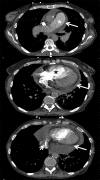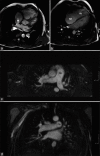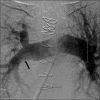A review of imaging modalities in pulmonary hypertension
- PMID: 28469715
- PMCID: PMC5399693
- DOI: 10.4103/1817-1737.203742
A review of imaging modalities in pulmonary hypertension
Abstract
Pulmonary hypertension (PH) is defined as resting mean pulmonary artery pressure ≥25 mmHg measured by right heart catheterization. PH is a progressive, life-threatening disease with a variety of etiologies. Swift and accurate diagnosis of PH and appropriate classification in etiologic group will allow for earlier treatment and improved outcomes. A number of imaging tools are utilized in the evaluation of PH, such as chest X-ray, computed tomography (CT), ventilation/perfusion (V/Q) scan, and cardiac magnetic resonance imaging. Newer imaging tools such as dual-energy CT and single-photon emission computed tomography/computed tomography V/Q scanning have also emerged; however, their place in the diagnostic evaluation of PH remains to be determined. In general, each imaging technique provides incremental information, with varying degrees of sensitivity and specificity, which helps suspect the presence and identify the etiology of PH. The present study aims to provide a comprehensive review of the utility, advantages, and shortcomings of the imaging modalities that may be used to evaluate patients with PH.
Keywords: Imaging; pulmonary hypertension; pulmonary vasculature; review; right ventricle.
Conflict of interest statement
There are no conflicts of interest.
Figures










Similar articles
-
Assessment of Right Ventricular Function in Pulmonary Hypertension with Multimodality Imaging.J Cardiovasc Imaging. 2018 Dec;26(4):189-200. doi: 10.4250/jcvi.2018.26.e28. Epub 2018 Dec 21. J Cardiovasc Imaging. 2018. PMID: 30607386 Free PMC article. Review.
-
Comprehensive imaging in patients with suspected pulmonary arterial hypertension.Heart. 2024 Jan 29;110(4):228-234. doi: 10.1136/heartjnl-2022-322182. Heart. 2024. PMID: 37463729 Review.
-
The role of imaging in pulmonary hypertension.Cardiovasc Diagn Ther. 2021 Jun;11(3):859-880. doi: 10.21037/cdt-20-295. Cardiovasc Diagn Ther. 2021. PMID: 34295710 Free PMC article. Review.
-
A Clinical Approach to Multimodality Imaging in Pulmonary Hypertension.Front Cardiovasc Med. 2022 Jan 18;8:794706. doi: 10.3389/fcvm.2021.794706. eCollection 2021. Front Cardiovasc Med. 2022. PMID: 35118142 Free PMC article. Review.
-
Imaging of Pulmonary Hypertension: Pictorial Essay.Chest. 2019 Aug;156(2):211-227. doi: 10.1016/j.chest.2019.04.003. Epub 2019 Apr 11. Chest. 2019. PMID: 30981724
Cited by
-
State of the Art in Pulmonary Arterial Hypertension: Molecular Basis, Imaging Modalities, and Right Heart Failure Treatment.Biomedicines. 2025 Jul 20;13(7):1773. doi: 10.3390/biomedicines13071773. Biomedicines. 2025. PMID: 40722843 Free PMC article. Review.
-
Emerging role of cardiovascular magnetic resonance imaging in the management of pulmonary hypertension.Eur Respir Rev. 2020 Jul 3;29(156):190138. doi: 10.1183/16000617.0138-2019. Print 2020 Jun 30. Eur Respir Rev. 2020. PMID: 32620585 Free PMC article. Review.
-
Hormone Replacement Therapy and Pulmonary Hypertension: A Review of the Literature.Cureus. 2024 Oct 20;16(10):e71908. doi: 10.7759/cureus.71908. eCollection 2024 Oct. Cureus. 2024. PMID: 39564039 Free PMC article. Review.
-
Investigation of a Novel Deep Learning-Based Computed Tomography Perfusion Mapping Framework for Functional Lung Avoidance Radiotherapy.Front Oncol. 2021 Mar 24;11:644703. doi: 10.3389/fonc.2021.644703. eCollection 2021. Front Oncol. 2021. PMID: 33842356 Free PMC article.
-
Pulmonary Blood Volume Measured by Dual-Energy Computed Tomography Can Help Distinguish Patients With Pulmonary Hypertension.Front Cardiovasc Med. 2022 Jul 5;9:835655. doi: 10.3389/fcvm.2022.835655. eCollection 2022. Front Cardiovasc Med. 2022. PMID: 35865383 Free PMC article.
References
-
- Simonneau G, Gatzoulis MA, Adatia I, Celermajer D, Denton C, Ghofrani A, et al. Updated clinical classification of pulmonary hypertension. J Am Coll Cardiol. 2013;62(25 Suppl):D34–41. - PubMed
-
- Galiè N, Humbert M, Vachiery JL, Gibbs S, Lang I, Torbicki A, et al. 2015 ESC/ERS Guidelines for the diagnosis and treatment of pulmonary hypertension: The Joint Task Force for the Diagnosis and Treatment of Pulmonary Hypertension of the European Society of Cardiology (ESC) and the European Respiratory Society (ERS): Endorsed by: Association for European Paediatric and Congenital Cardiology (AEPC), International Society for Heart and Lung Transplantation (ISHLT) Eur Heart J. 2016;37:67–119. - PubMed
-
- Hoeper MM, Bogaard HJ, Condliffe R, Frantz R, Khanna D, Kurzyna M, et al. Definitions and diagnosis of pulmonary hypertension. J Am Coll Cardiol. 2013;62(25 Suppl):D42–50. - PubMed
-
- McGoon MD, Benza RL, Escribano-Subias P, Jiang X, Miller DP, Peacock AJ, et al. Pulmonary arterial hypertension: Epidemiology and registries. J Am Coll Cardiol. 2013;62(25 Suppl):D51–9. - PubMed
-
- Farber HW, Miller DP, Poms AD, Badesch DB, Frost AE, Muros-Le Rouzic E, et al. Five-year outcomes of patients enrolled in the REVEAL Registry. Chest. 2015;148:1043–54. - PubMed
Publication types
Grants and funding
LinkOut - more resources
Full Text Sources
Other Literature Sources

